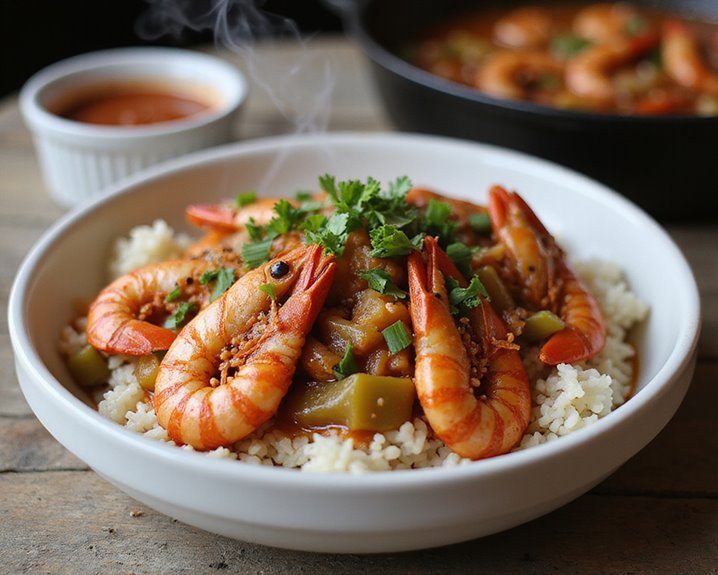Why You’ll Love this Soul-Warming Cajun Crawfish Etouffee
When the weather turns chilly or you’re simply craving something truly comforting, this Cajun Crawfish Etouffee is exactly what your soul needs. This rich, buttery dish transforms humble crawfish tails into something magical through the alchemy of Cajun cooking.
I’m obsessed with how the tender crawfish bathes in that velvety sauce—packed with the “holy trinity” of onions, bell peppers, and celery. Can you imagine the aroma that fills your kitchen? Divine.
What makes this recipe special is its authenticity, closely mirroring Pappadeux’s famous version. It’s surprisingly doable for home cooks but tastes like you’ve been perfecting it for generations. The balance of creole seasonings, fresh herbs, and that hint of crawfish fat creates depth that store-bought versions simply can’t match.
What Ingredients are in Soul-Warming Cajun Crawfish Etouffee?
Cajun Crawfish Etouffee is a classic Louisiana dish that showcases the rich, buttery flavor of crawfish in a thick, savory sauce. The combination of the “holy trinity” of Cajun cooking—onions, bell peppers, and celery—creates the aromatic base that makes this dish truly special. This soul-warming recipe brings authentic Cajun flavors right to your dinner table, perfect for those nights when you’re craving something hearty with a touch of Southern comfort.
- 2 pounds crawfish tails
- ¼ pound butter
- 1 cup minced onion
- ½ cup minced bell pepper
- ½ cup minced celery
- 2 tablespoons crawfish fat (can substitute butter)
- 2 cups cold water
- ¼ cup instant roux mix (or 2 tablespoons cornstarch)
- ¼ cup chopped green onion
- ¼ cup chopped parsley
- Creole seasoning to taste
- Pinch of salt
- Pinch of dried thyme
- Pinch of dried rosemary
- Pinch of dried oregano
- 1 bay leaf
When shopping for ingredients, fresh crawfish tails will give you the best flavor, but frozen ones work well too if you’re not in crawfish country. The crawfish fat is what gives authentic etouffee its distinctive richness—it’s that yellowish substance often packaged with crawfish tails. Can’t find it? No worries, just add a bit more butter. And while the recipe calls for instant roux mix, making your own roux from flour and fat is totally worth it if you have the time. Just cook equal parts flour and fat until it reaches a peanut butter color for that traditional etouffee flavor.
How to Make this Soul-Warming Cajun Crawfish Etouffee

Begin your etouffee adventure by seasoning 2 pounds of crawfish tails with a touch of salt and a gentle sprinkle of black and cayenne pepper. The seasoning isn’t just a suggestion—it’s the foundation of that authentic Cajun flavor we’re after.
Next, melt 1/4 pound of butter in a large sauté pan over medium heat, then add 1 cup of minced onion, 1/2 cup of minced bell pepper, and 1/2 cup of minced celery. This holy trinity of Cajun cooking needs about 5 minutes to soften and become translucent, releasing their aromatic magic into your kitchen.
Once your vegetables have softened, it’s time to add the secret weapon—2 tablespoons of crawfish fat (though extra butter works in a pinch if you’re without). Pour in 1-1/2 cups of water along with your seasonings: a pinch of salt, dried thyme, rosemary, oregano, and that essential bay leaf. Don’t forget the Creole seasoning blend, which ties everything together with its distinctive spice profile. Add those seasoned crawfish tails, bring the mixture to a gentle boil, then reduce the heat to low. Let it all simmer together for 30 minutes, allowing the flavors to meld into that rich, soul-warming goodness that defines a proper etouffee.
For the best results, invest in a quality Cajun cooking equipment set that includes a proper heavy-bottomed cast iron pot and traditional roux spoon.
For the final flourish, dissolve 1/4 cup of instant roux mix (or 2 tablespoons of cornstarch) in the remaining 1/2 cup of cold water, then stir this slurry into your simmering pot. This critical step transforms your dish from a soup to a proper etouffee with that characteristic velvety consistency. Continue stirring until you reach your preferred thickness—some like it looser, others more substantial. Finish by folding in 1/4 cup of chopped green onions and 1/4 cup of fresh parsley, which brighten the rich flavors and add a pop of color. Traditionally served over a bed of fluffy white rice, this crawfish etouffee brings the soul of Louisiana straight to your dinner table.
Soul-Warming Cajun Crawfish Etouffee Substitutions and Variations
Many home cooks wonder about adapting this classic dish when certain ingredients aren’t available—and I’m here to tell you that flexibility is part of the cajun cooking spirit.
Can’t find crawfish tails? Shrimp makes an excellent substitute, though you’ll want to cook them for less time. No crawfish fat? A bit more butter works just fine. Vegetarians might try mushrooms for that earthy depth.
The holy trinity (onions, celery, bell pepper) is pretty non-negotiable in cajun cooking, but the seasonings can be tweaked to your preference. Add a dash of hot sauce for extra kick, or tone down the cayenne if spice isn’t your thing. Some folks even add a splash of white wine or a dollop of tomato paste for complexity.
What to Serve with Soul-Warming Cajun Crawfish Etouffee
Three perfect accompaniments can transform your crawfish etouffee from a simple dish into a memorable cajun feast. First, fluffy white rice is non-negotiable—it catches every drop of that rich, buttery sauce. I’m talking about long-grain rice, cooked just right, slightly firm but tender.
Second, crusty French bread or garlic bread for sopping up the remaining sauce. Trust me, you won’t want to waste a single drop of that crawfish goodness.
Finally, a crisp side salad with a tangy vinaigrette provides the perfect contrast to the richness of the etouffee. Something simple—mixed greens, cucumber, and cherry tomatoes dressed with a light lemon dressing. The acidity cuts through the buttery sauce, invigorating your palate between bites.
Final Thoughts
Passion transforms an ordinary crawfish etouffee into something truly special. When you take the time to properly sauté those trinity vegetables until translucent, or patiently simmer your sauce to develop those deep Cajun flavors, you’re participating in a culinary tradition that spans generations.
I believe the beauty of this Pappadeux copycat recipe lies in its adaptability. Don’t have crawfish fat? A little extra butter works just fine. Need to adjust the thickness? That instant roux mix (or cornstarch in a pinch) gives you complete control.

